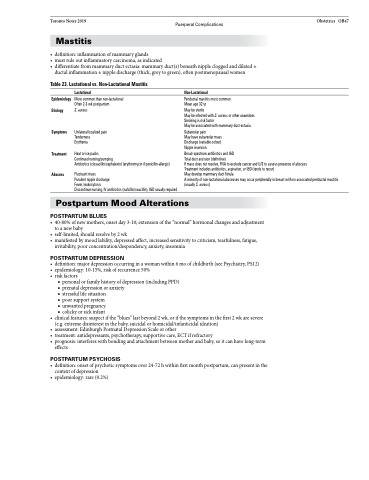Page 887 - TNFlipTest
P. 887
Toronto Notes 2019 Puerperal Complications Obstetrics OB47 Mastitis
• definition:inflammationofmammaryglands
• mustruleoutinflammatorycarcinoma,asindicated
• differentiatefrommammaryductectasia:mammaryduct(s)beneathnipplecloggedanddilated±
ductal inflammation ± nipple discharge (thick, grey to green), often postmenopausal women
Table 23. Lactational vs. Non-Lactational Mastitis
Epidemiology Etiology
Symptoms
Treatment
Abscess
Lactational
More common than non-lactational Often 2-3 wk postpartum
S. aureus
Unilateral localized pain Tenderness
Erythema
Heat or ice packs
Continued nursing/pumping
Antibiotics (cloxacillin/cephalexin) (erythromycin if penicillin-allergic)
Fluctuant mass
Purulent nipple discharge
Fever, leukocytosis
Discontinue nursing, IV antibiotics (nafcillin/oxacillin), I&D usually required
Non-Lactational
Periductal mastitis most common
Mean age 32 yr
May be sterile
May be infected with S. aureus or other anaerobes Smoking is risk factor
May be associated with mammary duct ectasia Subareolar pain
May have subareolar mass
Discharge (variable colour)
Nipple inversion
Broad-spectrum antibiotics and I&D
Total duct excision (definitive)
If mass does not resolve, FNA to exclude cancer and U/S to assess presence of abscess
Treatment includes antibiotics, aspiration, or I&D (tends to recur)
May develop mammary duct fistula
A minority of non-lactational abscesses may occur peripherally in breast with no associated periductal mastitis (usually S. aureus)
Postpartum Mood Alterations
POSTPARTUM BLUES
• 40-80%ofnewmothers,onsetday3-10;extensionofthe“normal”hormonalchangesandadjustment to a new baby
• self-limited,shouldresolveby2wk
• manifestedbymoodlability,depressedaffect,increasedsensitivitytocriticism,tearfulness,fatigue,
irritability, poor concentration/despondency, anxiety, insomnia
POSTPARTUM DEPRESSION
• definition:majordepressionoccurringinawomanwithin6moofchildbirth(seePsychiatry,PS12) • epidemiology:10-15%,riskofrecurrence50%
• riskfactors
■ personal or family history of depression (including PPD) ■ prenatal depression or anxiety
■ stressful life situation
■ poor support system
■ unwanted pregnancy
■ colicky or sick infant
• clinicalfeatures:suspectifthe“blues”lastbeyond2wk,orifthesymptomsinthefirst2wkaresevere
(e.g. extreme disinterest in the baby, suicidal or homicidal/infanticidal ideation)
• assessment:EdinburghPostnatalDepressionScaleorother
• treatment:antidepressants,psychotherapy,supportivecare,ECTifrefractory
• prognosis:interfereswithbondingandattachmentbetweenmotherandbaby,soitcanhavelong-term
effects
POSTPARTUM PSYCHOSIS
• definition:onsetofpsychoticsymptomsover24-72hwithinfirstmonthpostpartum,canpresentinthe context of depression
• epidemiology:rare(0.2%)


